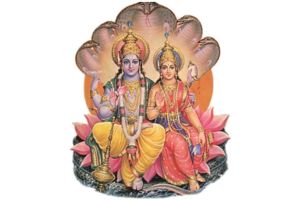Vishnu Dev & Laxmi Devi - The Preserver
Lord Vishnu is eternal – self-born and self-existing. He emerges from the cosmic ocean during the creation of the universe, and resting on Ananta Shesha.

Union of Vishnu Dev & Laxmi Devi

Devas (gods) and Asuras (demons) joined forces to churn the ocean to obtain the elixir of immortality, called Amrita, which was hidden at the bottom of the ocean. Mount Mandara was uprooted and used as the churning rod and Vasuki, the king of serpents who reside on Shiva’s neck, became the churning rope. The churning produced many divine beings and objects. As the churning continued Goddess Lakshmi emerged from the depths of the ocean standing on a lotus flower. She was radiant and adorned with divine beauty signifying her association with wealth and abundance. Recognising her as a divine entity both Devas and Asuras sought her hand in marriage. However, she chose Vishnu as her consort considering him to be the supreme divine being.
However, the Samudra Manthan also produced a deadly poison called Halahala, which threatened to destroy the universe. Shiva came to the rescue and swallowed the poison, but his throat turned blue due to its effect. Hence, he is also called Neelakantha.
Finally, Dhanvantari, the god of medicine, emerged with a pot of Amrita in his hands. The Devas and the Asuras began fighting over it. Vishnu as Mohini appeared and, kept the Asuras away from Amrita and, Dhanvantari distributed Amrita to Devas.
Svarbhanu Asura disguised himself as a Deva and drank the Amrita from Mohini. However, he was recognised by Surya Dev and Chandra Dev and, Mohini was informed. Mohini then cuts off his head with her discus, the Sudarshana Chakra. Since Svarbhanu Asura had already consumed the Amrita, he became immortal. His head became Rahu, and his body became Ketu.
Ekadasi
The Moon influences the mind in its orbital relative movement, when waxes or wanes, with reference to other planets.
Ekadasi first appeared from Lord Vishnu during the waning Moon in the month of Margashirsha also referred to as Agrahayana, in order to kill the demon Mura. Ekadasi is a Sanskrit word, which means ‘the eleventh’. It refers to the eleventh day of a fortnight belonging to a lunar month. The Ekadasi day in both fortnights is the occasion when the mind finds itself in its place – in the bright fortnight (Purnima / Full Moon in Shukla Paksha) in the Ajna Chakra, and in the dark fortnight (Amavasya / New Moon in Krishna Paksha) in the Anahata Chakra.
We have certain energy-centres called Chakras in the body which whirl in some direction as water whirls in a river. These Chakras are neither in the mind nor in the body; they are in the astral body – the mind moves through these Chakras. When this operation takes place consciously, it is called Yoga. When done unconsciously, it is called Influence. Third Eye Chakra, also known as Ajna, is situated in the centre of the forehead, between the eyebrows. It governs our intuition, imagination, and spiritual insight. Heart Chakra, also known as Anahata, is situated in the centre of the chest. It is associated with balance, calmness, and serenity.
Our energies change in Pournami and Amavasya. Pournami is the presence of light. It is nurturing; seeking wellbeing in Pournami is sacred. Amavasya is the absence of light. It is transforming; seeking liberation in Amavasya is sacred. Amavasya is a day when one can become easily aware of, ‘What is me and what is not me,’ and from there on, the journey from untruth to truth begins. One day before Amavasya is known as Shivarathri.
Ekadashi symbolises eleven senses constituting five karmendriyas, five gyanendriyas and one antaḥkaraṇa.
Ekadasi is observed to serve Lord Vishnu, and gain control over the mind and bodily senses, and channel the energies towards spiritual progression. There are usually 24 Ekadasi Days in a calendar year. Occasionally, there are two extra Ekadasi Days that happen in a leap year.
Papmochani Ekadashi is the 11th day of Kishna Paksha in Chaitra. On this auspicious day we sacrifice all those anchors that hold us back.
Kamada Ekadashi is the 11th day of Shukla Paksha in Chaitra. On this auspicious day we sacrifice all those anchors that hold us back from meeting our desires.
Varuthini Ekadashi is the 11th day of Kishna Paksha in Vaisakha. On this auspicious day we sacrifice unhealthy anchors.
Mohini Ekadashi is the 11th day of Shukla Paksha in Vaisakha. On this auspicious day we sacrifice materialistic anchors. Lord Vishnu incarnated as Mohini to distribute Amrit to Devas.
Apara Ekadashi is the 11th day of Kishna Paksha in Jyeshtha. On this auspicious day we receive ‘apara’ which means ‘limitless’ anchors – it is more about accepting anchors with positive energies, and sacrificing anchors with negative energies.
Nirjala Ekadashi is the 11th day of Shukla Paksha in Jyeshtha. Nir means ‘no’ and Jala means ‘water’. On this auspicious day we overcome anchors that hold us back.
Yogini Ekadashi is the 11th day of Kishna Paksha in Ashadh.
Devshayani Ekadashi is the 11th day of Shukla Paksha in Ashadh. From this auspicious day onwards the Lord Vishnu remains in sleep (Yog Nidra) for four months (the Chaturmas). After four months, Lord Vishnu wakes up from sleep on the day of Prabodhini Ekadashi and after that, all auspicious work starts.
Kamika Ekadashi is the 11th day of Kishna Paksha in Shravana. It is the first Ekadashi in Chaturmas. This auspicious day is dedicated to worshiping Lord Krishna.
Putrada Ekadashi is the 11th day of Shukla Paksha in Shravana. It is the second Ekadashi in Chaturmas. Putrada means ‘giver of sons’ who takes care of his parents during their old age.
Paramaa Ekadashi is the 11th day of Kishna Paksha in Adhikamas. Adhikamas is an extra lunar month that comes once every three years (Leap Year). From this auspicious day onwards the Lord Vishnu remains in sleep (Yog Nidra) for four months (the Chaturmas).
Padmini Ekadashi is the 11th day of Shukla Paksha in Adhikamas. Adhikamas is an extra lunar month that comes once every three years (Leap Year). Padmini Ekadashi is the first Ekadashi in Chaturmas.
Aja Ekadashi is the 11th day of Kishna Paksha in Bhadrapada. It is the third Ekadashi in Chaturmas.
Parsva Ekadashi, also known as Parivartini Ekadashi, is the 11th day of Shukla Paksha in Bhadrapada. It is the fourth Ekadashi in Chaturmas. Parivartan means Change. Lord Vishnu took his first turn while sleeping. This auspicious day is dedicated to worshiping Vamana avatar.
Indira Ekadashi, also known as Shradh Ekadashi, is the 11th day of Kishna Paksha in Ashwin. It is the fifth Ekadashi in Chaturmas. This auspicious day is dedicated to special prayers to Yamraj in the loving memory of the ancestors.
Papankusha Ekadashi is the 11th day of Shukla Paksha in Ashwin. It is the sixth Ekadashi in Chaturmas. This auspicious day is dedicated to worshiping Lord Padmanabha.
Rama Ekadashi is the 11th day of Kishna Paksha in Kartik. It is the final and seventh Ekadashi in Chaturmas. Rama is one of the names given to MahaLakshmi.
Prabodhini Ekadashi, also known as Dev Uthani Ekadashi, is the 11th day of Shukla Paksha in Kartik. ‘Dev Uthani’ means ‘to wake up God’. It marks the end of Chaturmas, a four-month-long period during which Lord Vishnu remains asleep. Tulsi Vivah is organized in many temples. Those who don’t have a girl child get the happiness of doing Kanyadaan during Tulsi Vivah.
Utpanna Ekadashi is the 11th day of Kishna Paksha in Agrahayana.
Mokshada Ekadashi, also known as Baikuntha Ekadashi, is the 11th day of Shukla Paksha in Agrahayana. Moksha means liberation. This auspicious day is dedicated to special prayers for getting rid of the malefic effects of Rahu, Ketu, Mangal and Shani.
Saphala Ekadashi is the 11th day of Kishna Paksha in Pausha. Saphala means ‘to prosper’. On this auspicious day a holy dip in the Ganges holds special significance.
Pausha Putrada Ekadashi, also known as Vaikunta Ekadashi, is the 11th day of Shukla Paksha in Pausha. Putrada means ‘giver of sons’ who takes care of his parents during their old age.
Shat Tila Ekadashi is the 11th day of Kishna Paksha in Magha. Tila means sesame. On this auspicious day, Til Daan and Til Tarpan hold special significance.
Jaya Ekadashi is the 11th day of Shukla Paksha in Magha.
Vijaya Ekadashi is the 11th day of Kishna Paksha in Falgun. Vijaya means victory. On this auspicious day ancestors escape hell for heaven.
Amalaki Ekadashi is the 11th day of Shukla Paksha in Falgun. Amalaki means Gooseberry, also known as nectar fruit. When Lord Brahma was creating the universe, on this auspicious day Lord Vishnu wished for Gooseberry trees.
Action Organ – Vak-tattva – Organs of Speech
Action Organ – Pani-tattva – Hands for Grasping
Action Organ – Pada-tattva – Feet for Walking
Action Organ – Payu-tattva – Anus for Excretion
Action Organ – Upastha-tattva – Genitals for Procreation
সত্য-যুগে
মৎস্য, কূর্ম,
বরাহ, নৃসিংহ;
ত্রেতায় – বামন, পরশুরাম-রাম;
দ্বাপরয় – শ্রীকৃষ্ণ, গৌতম বুদ্ধ;
কলি-যুগে
কল্কি
রূপে লক্ষ্মীকান্তং বিষ্ণু দেবায় হরে হরে।
পদ্মনাভং সরস্বতী ব্রহ্মায়;
পার্বতী আদিপুরুষ, অর্ধনারীশ্বর মহাদেব ভ্রাতায় হরে হরে।
ওঁ বিষ্ণু দেবায় -লক্ষ্মী দেবী নমঃ।।
বিষ্ণু দেব–লক্ষ্মী দেবী, তোমাদের আহ্বান করি, প্রণাম করি।
শান্তাকারং (যাঁর আকৃতি অতিশয় শান্ত)
ভুজগশয়নং (যিনি শেষনাগের শয্যার উপরে শয়ন করে আছেন)
পদ্মনাভং (যাঁর নাভিতে কমল আছে)
সুরেশং (দেবতাদের যিনি ঈশ্বর)
বিশ্বাধারং (সমগ্র জগতের আধার)
গগনসদৃশং (যিনি আকাশের মতো ব্যাপ্ত)
মেঘবর্ণং (নীল মেঘের মতো যাঁর বর্ণ)
শুভাঙ্গম্। (যাঁর সকল অঙ্গ অতিশয় সুন্দর)
লক্ষ্মীকান্তং (শ্রীলক্ষ্মীপতি)
কমলনয়নং (কমলের মতো নয়ন)
যোগিভ্যিানগম্যং (যিনি যোগীদের ধ্যানের দ্বারা প্রাপ্ত হন)
বন্দে (আমি প্রণাম করছি)
বিষ্ণু (ভগবান বিষ্ণুকে)
ভবভয়হরং (যিনি জন্ম-মরণরূপ ভয়ের নাশকারী)
সর্বলোকৈকনাথম্ ॥ (যিনি সকল লোকের স্বামী)
বিষ্ণু দেব–লক্ষ্মী দেবী, তোমাদের নমস্কার করি।
যং ব্রহ্মাবরুণেন্দ্ররুদ্রমরুতঃ (ব্রহ্মা, বরুণ, ইন্দ্র, রুদ্র ও মরুদ্গণ)
স্তন্বন্তি দিব্যৈঃ (দিব্যস্তোত্র দ্বারা যাঁর স্তুতি করেন)
স্তবৈর্বেদেঃ (বেদের দ্বারা যাঁর গান করেন)
সাঙ্গপদক্রমোপনিষদৈর্গায়ন্তি (অঙ্গ, পদ, ক্রম এবং উপনিষদের সঙ্গে)
যং সামগাঃ। (সামবেদ গায়কগণ)
ধ্যানাবস্থিততদ্গতেন (ধ্যানস্থিত তদ্গতমনা হয়ে)
মনসা পশ্যন্তি (যাঁর দর্শন করে থাকেন)
যং যোগিনো (যোগীরা)
যস্যান্তং ন বিদুঃ সুরাসুরগণা (দেবতা এবং অসুরগণ কেউই যাঁর অন্ত জানে না)
দেবায় (সেই পরমপুরুষ নারায়ণ দেবতাকে)
তস্মৈ (আমার)
নমঃ ॥ (নমস্কার)
গীতা সুগীতা কর্তব্যা কিমন্যৈঃ শাস্ত্রবিস্তরৈঃ।
যা স্বয়ং পদ্মনাভস্য মুখপদ্মাদ্বিনিঃসৃতা ॥
বিষ্ণু দেব–লক্ষ্মী দেবী, সকলের কর্মেন্দ্রিয়-এর ব্যবহার, সবসময় সবার জন্য সুস্থকর থাকুক, এই প্রার্থনা করি।

